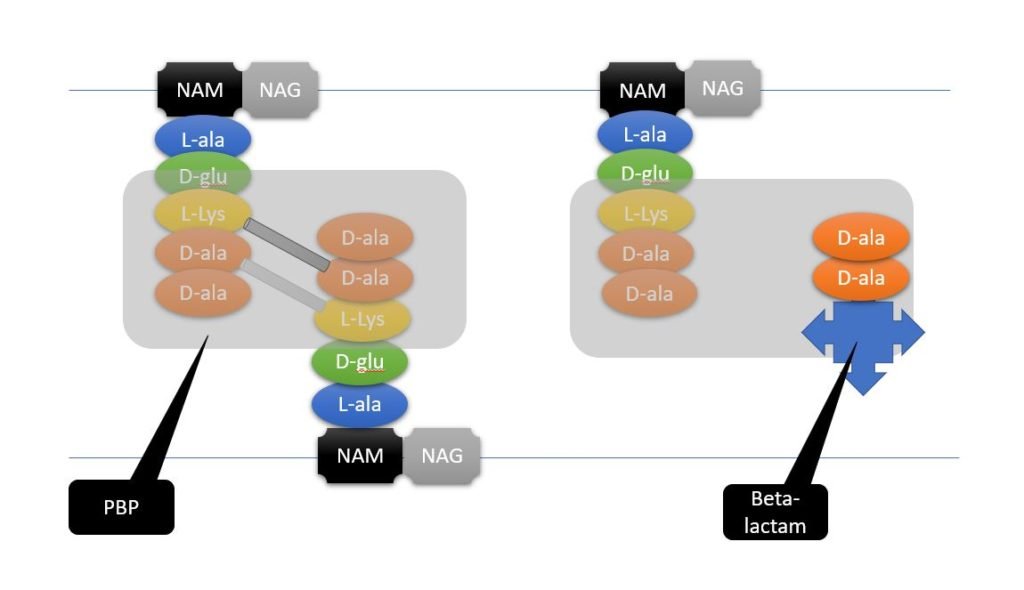Cefiderocol
Class and Chemical Structure
It is a Siderophore cephalosporin, a synthetic conjugate of a cephalosporin moiety and a siderophore moiety. Siderophore moiety binds to the iron and helps the antibiotic to gain entry into bacterial cells using active iron transporters (e.g. CirA and Fiu in E coli, PiuA in P. aeruginosa)– a “Trojan horse” like approach.

The chemical structure is similar to both ceftazidime and cefepime.
It has high stability against beta-lactamase, including ESBL, ampC and carbapenemases. Modifications of C-7 (a carboxypropanoxyimino group, like ceftazidime) and C-3 ( pyrrolidinium group, like cefepime) side chains lead to the stability against β-lactamases, including carbapenemases.
Mechanism of action of cefiderocol
Cefiderocol’s mechanism of action is similar to other beta-lactams – It binds to the Penicillin-binding proteins (PBP) to prevent cell wall formation. It has a high affinity for PBP3.

The main component of the bacterial cell wall is peptidoglycan, which helps bacteria retain stability against osmotic pressure and maintain shape and morphology. Peptidoglycan comprises two amino sugars: N-acetylglucosamine (NAG) and N-acetylmuramic acid (NAM). A pentapeptide structure is attached to NAM (see picture: L-ala to D-ala), with two terminal D-ala
PBP, an enzyme, helps to establish a cross-link between L-lys and the 4th D-ala. This cross-link provides structural strength to the cell wall. Bata-lactams, with a similar alanyl-alanine structure, binds to the PBP and prevent the cross-linking and hence, cell wall formation.
Mechanism of resistance of cefiderocol
Some mutations, especially in iron transporters, are associated with an increase in minimum inhibitory concentration (MIC). Some beta-lactamase enzymes may also have a similar effect.
- Mutations in upstream regions of pvdS , which regulates pyoverdine synthesis – overexpression of pyoverdine.
- Mutation in fecI , which regulates the synthesis of iron transporter FecA contributes to the transport of iron citrate.
- Mutation in the iron transporters CirA, Fiu, PiuA.
- D179Y mutation in the Ω-loop of KPC β-lactamases
- Some serine and metallo-betalactamases may increase MIC (PER, NDM) [Yamano]
However, cefiderocol –
- Is not/less affected by porin loss (ompK, oprD) or upregulation of efflux (MexA-MexB-OprM).
- Is stable against many serine and metallo-beta-lactamases. – KPC, OXA, VIM etc. Some resistance has been noted in NDM and PER producers.
- Is less/not affected by the overproduction of class C beta-lactamase – ampC (e.g dacB gene-mediated).
- Is not affected by PBP3 mutation like YRIN (ftsI gene-mediated) or YRIK insertion in E coli (It affects beta-lactams except carbapenems).
PK/PD of cefiderocol
- Three-compartment linear model.
- Mean plasma half-life (t½) ~ 2.3 h.
- Protein binding – 58%.
- Total drug clearance – 4.6-6.0 L/h.
- Primarily excretion -renally, unchanged – 61-71%
- Dose adjustment required in renal impairment
- Most important pharmacodynamic index predicting clinical outcome: T > MIC (percentage of time that free drug concentrations exceed the minimum inhibitory concentration).
Spectrum
It is active against:
Enterobacteriaceae – E coli, Klebsiella, Enterobacter etc.
Nonfermenting bacteria: Pseudomonas, Acinetobacter spp, Burkholderia spp, Stenotrophomonas maltophilia.
Other gram negatives – Haemophilus, Moraxella, Bordetella
Higher MIC was seen in Campylobacter, ceftriaxone R gonococcus, and gram-positive bacteria.
Anaerobe sensitivity is variable (as anaerobes rely less on the siderophore system).
Use
It is licensed for –
For the treatment of complicated urinary tract infections (cUTI), including pyelonephritis caused by susceptible Gram-negative microorganisms, patients 18 years of age or older have limited or no alternative treatment options. (FDA).
Infections due to aerobic Gram-negative organisms in adults with limited treatment options (EMA)
Studies and papers
Global surveillance studies, SIDERO-WT and SIDERO-CR
APEKS-cUTI
CREDIBLE – CR
Papers:
https://academic.oup.com/cid/article/69/Supplement_7/S519/5624002
https://academic.oup.com/cid/article/69/Supplement_7/S538/5624004
https://academic.oup.com/cid/article/69/Supplement_7/S544/5624008
